Project Report: DRTV Taxonomy for Skull Surgery Navigation System
VerifiedAdded on 2022/09/12
|9
|1424
|15
Project
AI Summary
This project delves into the application of a DRTV (Data, Registration, Tracking through Navigation and View) taxonomy for an augmented reality navigation system designed for skull surgery. The student's work begins with a rationale that highlights the limitations of traditional surgical methods and the benefits of augmented reality in providing 3D visual images, reducing operation time, and minimizing the mental workload of surgeons. The project addresses specific research questions regarding the problems solved by augmented reality, the system's impact on surgical quality, and the role of the new DRTV taxonomy. The conceptual framework emphasizes the advantages of self-developed augmented reality in endoscopic and skull base surgeries, leading to reduced judgment time for surgeons. The methodology involves qualitative research, analyzing journal articles and secondary data collection methods to assess the system's effectiveness. The project also addresses ethical issues, compliance requirements, and includes a detailed project plan with deliverables like an annotated bibliography and a report. Risk analysis, duration, and a Gantt chart provide insights into the project's timeline. The project concludes with a bibliography of relevant sources, supporting the research and findings on the innovative use of augmented reality in skull surgery.
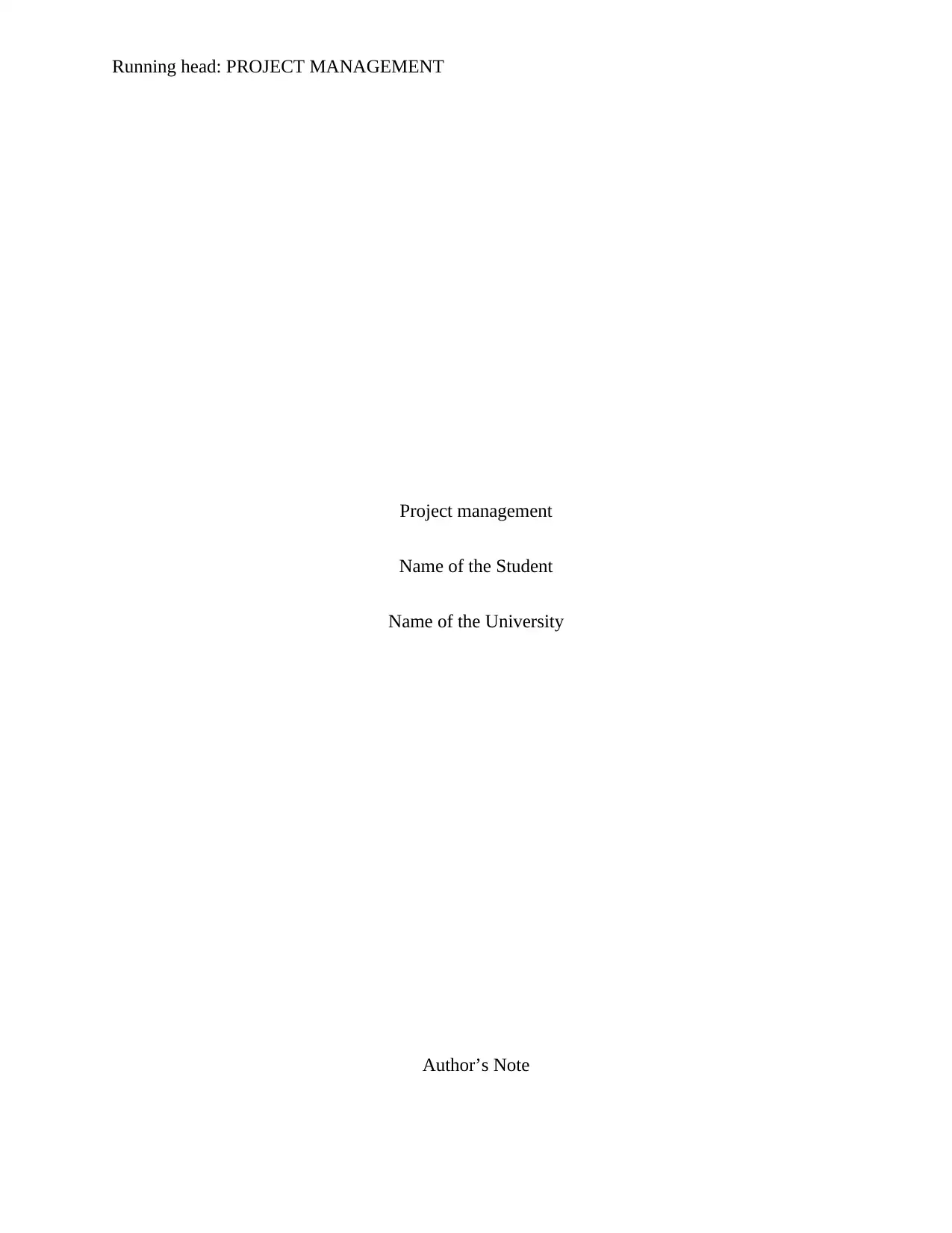
Running head: PROJECT MANAGEMENT
Project management
Name of the Student
Name of the University
Author’s Note
Project management
Name of the Student
Name of the University
Author’s Note
Paraphrase This Document
Need a fresh take? Get an instant paraphrase of this document with our AI Paraphraser
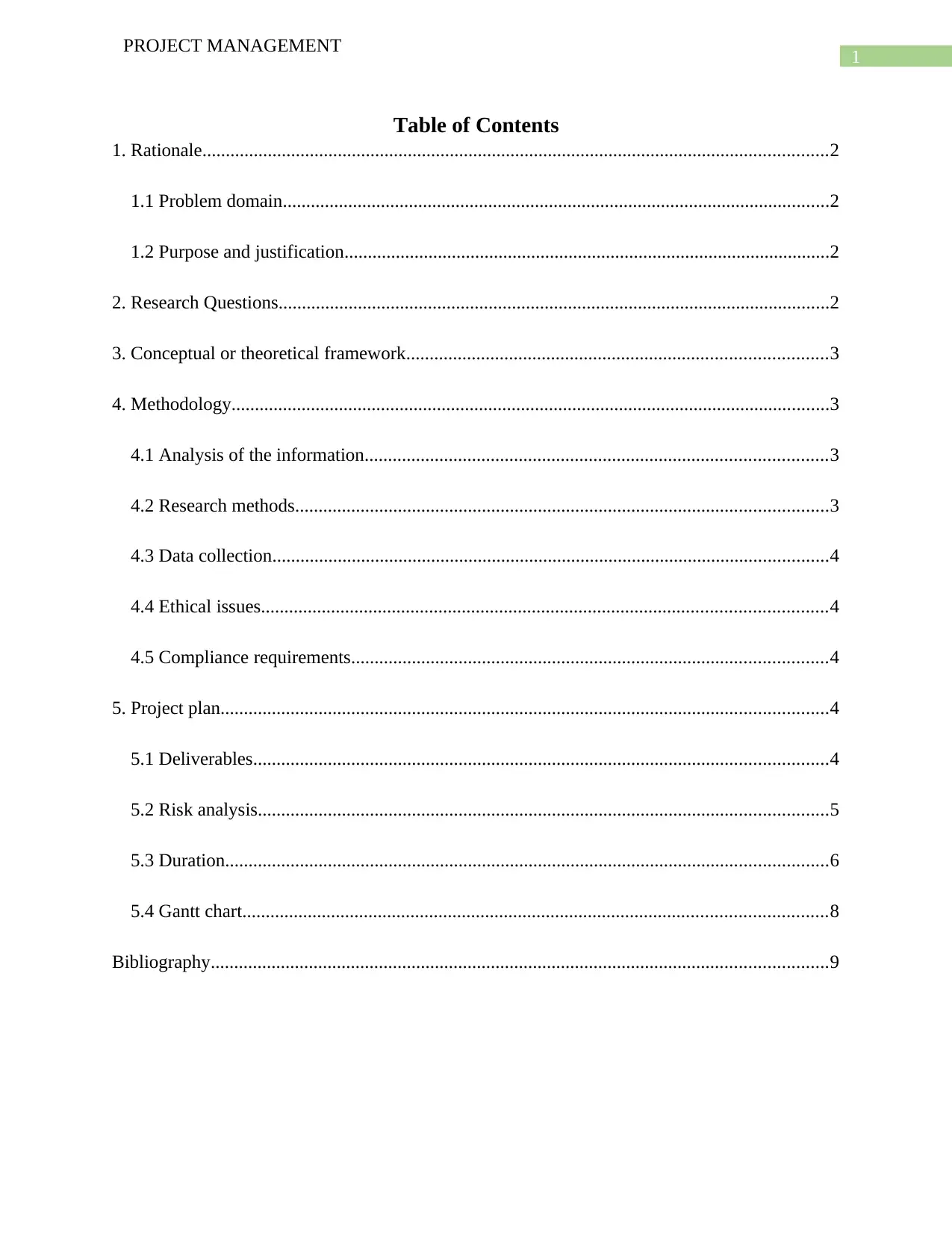
1
PROJECT MANAGEMENT
Table of Contents
1. Rationale......................................................................................................................................2
1.1 Problem domain.....................................................................................................................2
1.2 Purpose and justification........................................................................................................2
2. Research Questions......................................................................................................................2
3. Conceptual or theoretical framework..........................................................................................3
4. Methodology................................................................................................................................3
4.1 Analysis of the information...................................................................................................3
4.2 Research methods..................................................................................................................3
4.3 Data collection.......................................................................................................................4
4.4 Ethical issues.........................................................................................................................4
4.5 Compliance requirements......................................................................................................4
5. Project plan..................................................................................................................................4
5.1 Deliverables...........................................................................................................................4
5.2 Risk analysis..........................................................................................................................5
5.3 Duration.................................................................................................................................6
5.4 Gantt chart.............................................................................................................................8
Bibliography....................................................................................................................................9
PROJECT MANAGEMENT
Table of Contents
1. Rationale......................................................................................................................................2
1.1 Problem domain.....................................................................................................................2
1.2 Purpose and justification........................................................................................................2
2. Research Questions......................................................................................................................2
3. Conceptual or theoretical framework..........................................................................................3
4. Methodology................................................................................................................................3
4.1 Analysis of the information...................................................................................................3
4.2 Research methods..................................................................................................................3
4.3 Data collection.......................................................................................................................4
4.4 Ethical issues.........................................................................................................................4
4.5 Compliance requirements......................................................................................................4
5. Project plan..................................................................................................................................4
5.1 Deliverables...........................................................................................................................4
5.2 Risk analysis..........................................................................................................................5
5.3 Duration.................................................................................................................................6
5.4 Gantt chart.............................................................................................................................8
Bibliography....................................................................................................................................9
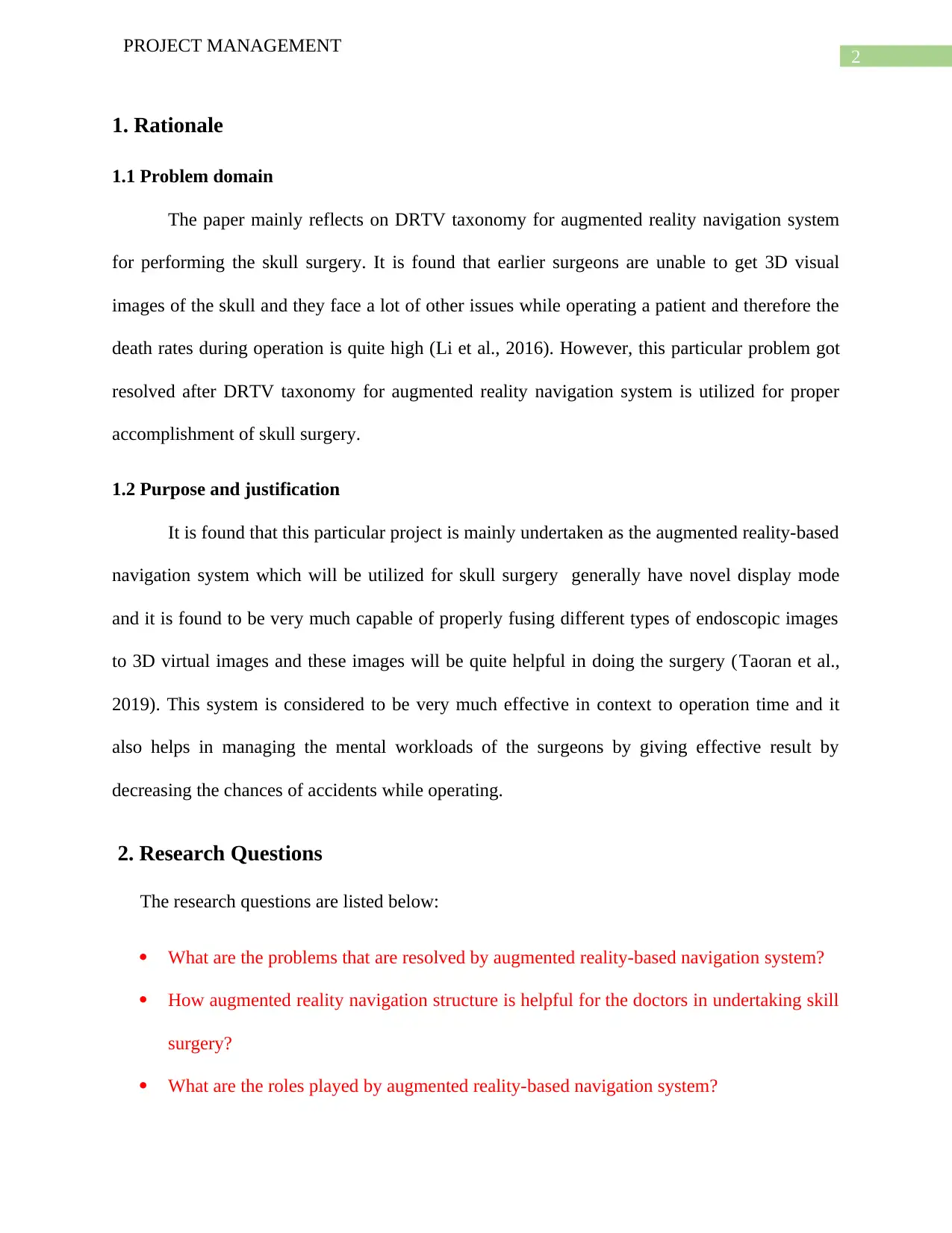
2
PROJECT MANAGEMENT
1. Rationale
1.1 Problem domain
The paper mainly reflects on DRTV taxonomy for augmented reality navigation system
for performing the skull surgery. It is found that earlier surgeons are unable to get 3D visual
images of the skull and they face a lot of other issues while operating a patient and therefore the
death rates during operation is quite high (Li et al., 2016). However, this particular problem got
resolved after DRTV taxonomy for augmented reality navigation system is utilized for proper
accomplishment of skull surgery.
1.2 Purpose and justification
It is found that this particular project is mainly undertaken as the augmented reality-based
navigation system which will be utilized for skull surgery generally have novel display mode
and it is found to be very much capable of properly fusing different types of endoscopic images
to 3D virtual images and these images will be quite helpful in doing the surgery (Taoran et al.,
2019). This system is considered to be very much effective in context to operation time and it
also helps in managing the mental workloads of the surgeons by giving effective result by
decreasing the chances of accidents while operating.
2. Research Questions
The research questions are listed below:
What are the problems that are resolved by augmented reality-based navigation system?
How augmented reality navigation structure is helpful for the doctors in undertaking skill
surgery?
What are the roles played by augmented reality-based navigation system?
PROJECT MANAGEMENT
1. Rationale
1.1 Problem domain
The paper mainly reflects on DRTV taxonomy for augmented reality navigation system
for performing the skull surgery. It is found that earlier surgeons are unable to get 3D visual
images of the skull and they face a lot of other issues while operating a patient and therefore the
death rates during operation is quite high (Li et al., 2016). However, this particular problem got
resolved after DRTV taxonomy for augmented reality navigation system is utilized for proper
accomplishment of skull surgery.
1.2 Purpose and justification
It is found that this particular project is mainly undertaken as the augmented reality-based
navigation system which will be utilized for skull surgery generally have novel display mode
and it is found to be very much capable of properly fusing different types of endoscopic images
to 3D virtual images and these images will be quite helpful in doing the surgery (Taoran et al.,
2019). This system is considered to be very much effective in context to operation time and it
also helps in managing the mental workloads of the surgeons by giving effective result by
decreasing the chances of accidents while operating.
2. Research Questions
The research questions are listed below:
What are the problems that are resolved by augmented reality-based navigation system?
How augmented reality navigation structure is helpful for the doctors in undertaking skill
surgery?
What are the roles played by augmented reality-based navigation system?
⊘ This is a preview!⊘
Do you want full access?
Subscribe today to unlock all pages.

Trusted by 1+ million students worldwide
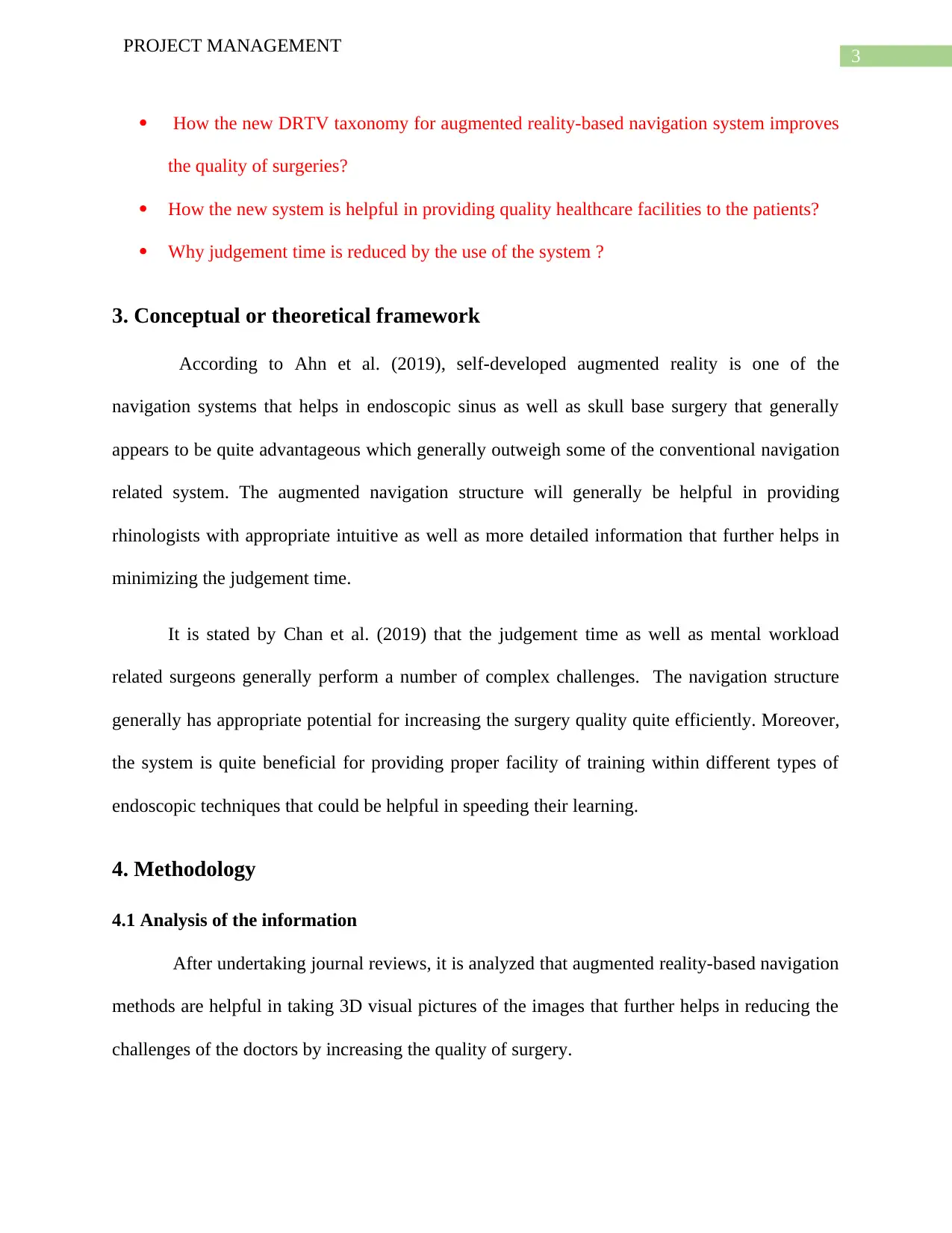
3
PROJECT MANAGEMENT
How the new DRTV taxonomy for augmented reality-based navigation system improves
the quality of surgeries?
How the new system is helpful in providing quality healthcare facilities to the patients?
Why judgement time is reduced by the use of the system ?
3. Conceptual or theoretical framework
According to Ahn et al. (2019), self-developed augmented reality is one of the
navigation systems that helps in endoscopic sinus as well as skull base surgery that generally
appears to be quite advantageous which generally outweigh some of the conventional navigation
related system. The augmented navigation structure will generally be helpful in providing
rhinologists with appropriate intuitive as well as more detailed information that further helps in
minimizing the judgement time.
It is stated by Chan et al. (2019) that the judgement time as well as mental workload
related surgeons generally perform a number of complex challenges. The navigation structure
generally has appropriate potential for increasing the surgery quality quite efficiently. Moreover,
the system is quite beneficial for providing proper facility of training within different types of
endoscopic techniques that could be helpful in speeding their learning.
4. Methodology
4.1 Analysis of the information
After undertaking journal reviews, it is analyzed that augmented reality-based navigation
methods are helpful in taking 3D visual pictures of the images that further helps in reducing the
challenges of the doctors by increasing the quality of surgery.
PROJECT MANAGEMENT
How the new DRTV taxonomy for augmented reality-based navigation system improves
the quality of surgeries?
How the new system is helpful in providing quality healthcare facilities to the patients?
Why judgement time is reduced by the use of the system ?
3. Conceptual or theoretical framework
According to Ahn et al. (2019), self-developed augmented reality is one of the
navigation systems that helps in endoscopic sinus as well as skull base surgery that generally
appears to be quite advantageous which generally outweigh some of the conventional navigation
related system. The augmented navigation structure will generally be helpful in providing
rhinologists with appropriate intuitive as well as more detailed information that further helps in
minimizing the judgement time.
It is stated by Chan et al. (2019) that the judgement time as well as mental workload
related surgeons generally perform a number of complex challenges. The navigation structure
generally has appropriate potential for increasing the surgery quality quite efficiently. Moreover,
the system is quite beneficial for providing proper facility of training within different types of
endoscopic techniques that could be helpful in speeding their learning.
4. Methodology
4.1 Analysis of the information
After undertaking journal reviews, it is analyzed that augmented reality-based navigation
methods are helpful in taking 3D visual pictures of the images that further helps in reducing the
challenges of the doctors by increasing the quality of surgery.
Paraphrase This Document
Need a fresh take? Get an instant paraphrase of this document with our AI Paraphraser
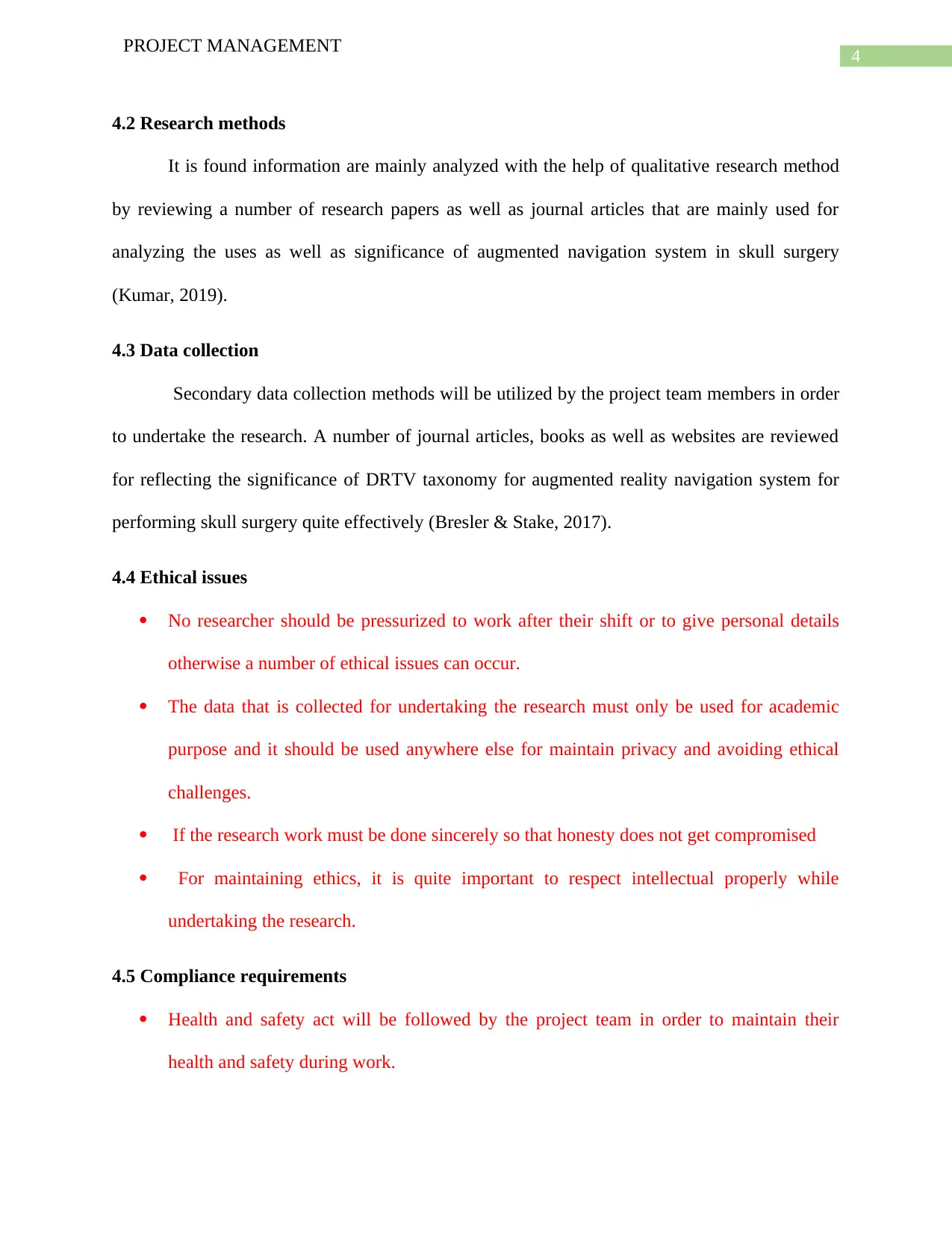
4
PROJECT MANAGEMENT
4.2 Research methods
It is found information are mainly analyzed with the help of qualitative research method
by reviewing a number of research papers as well as journal articles that are mainly used for
analyzing the uses as well as significance of augmented navigation system in skull surgery
(Kumar, 2019).
4.3 Data collection
Secondary data collection methods will be utilized by the project team members in order
to undertake the research. A number of journal articles, books as well as websites are reviewed
for reflecting the significance of DRTV taxonomy for augmented reality navigation system for
performing skull surgery quite effectively (Bresler & Stake, 2017).
4.4 Ethical issues
No researcher should be pressurized to work after their shift or to give personal details
otherwise a number of ethical issues can occur.
The data that is collected for undertaking the research must only be used for academic
purpose and it should be used anywhere else for maintain privacy and avoiding ethical
challenges.
If the research work must be done sincerely so that honesty does not get compromised
For maintaining ethics, it is quite important to respect intellectual properly while
undertaking the research.
4.5 Compliance requirements
Health and safety act will be followed by the project team in order to maintain their
health and safety during work.
PROJECT MANAGEMENT
4.2 Research methods
It is found information are mainly analyzed with the help of qualitative research method
by reviewing a number of research papers as well as journal articles that are mainly used for
analyzing the uses as well as significance of augmented navigation system in skull surgery
(Kumar, 2019).
4.3 Data collection
Secondary data collection methods will be utilized by the project team members in order
to undertake the research. A number of journal articles, books as well as websites are reviewed
for reflecting the significance of DRTV taxonomy for augmented reality navigation system for
performing skull surgery quite effectively (Bresler & Stake, 2017).
4.4 Ethical issues
No researcher should be pressurized to work after their shift or to give personal details
otherwise a number of ethical issues can occur.
The data that is collected for undertaking the research must only be used for academic
purpose and it should be used anywhere else for maintain privacy and avoiding ethical
challenges.
If the research work must be done sincerely so that honesty does not get compromised
For maintaining ethics, it is quite important to respect intellectual properly while
undertaking the research.
4.5 Compliance requirements
Health and safety act will be followed by the project team in order to maintain their
health and safety during work.
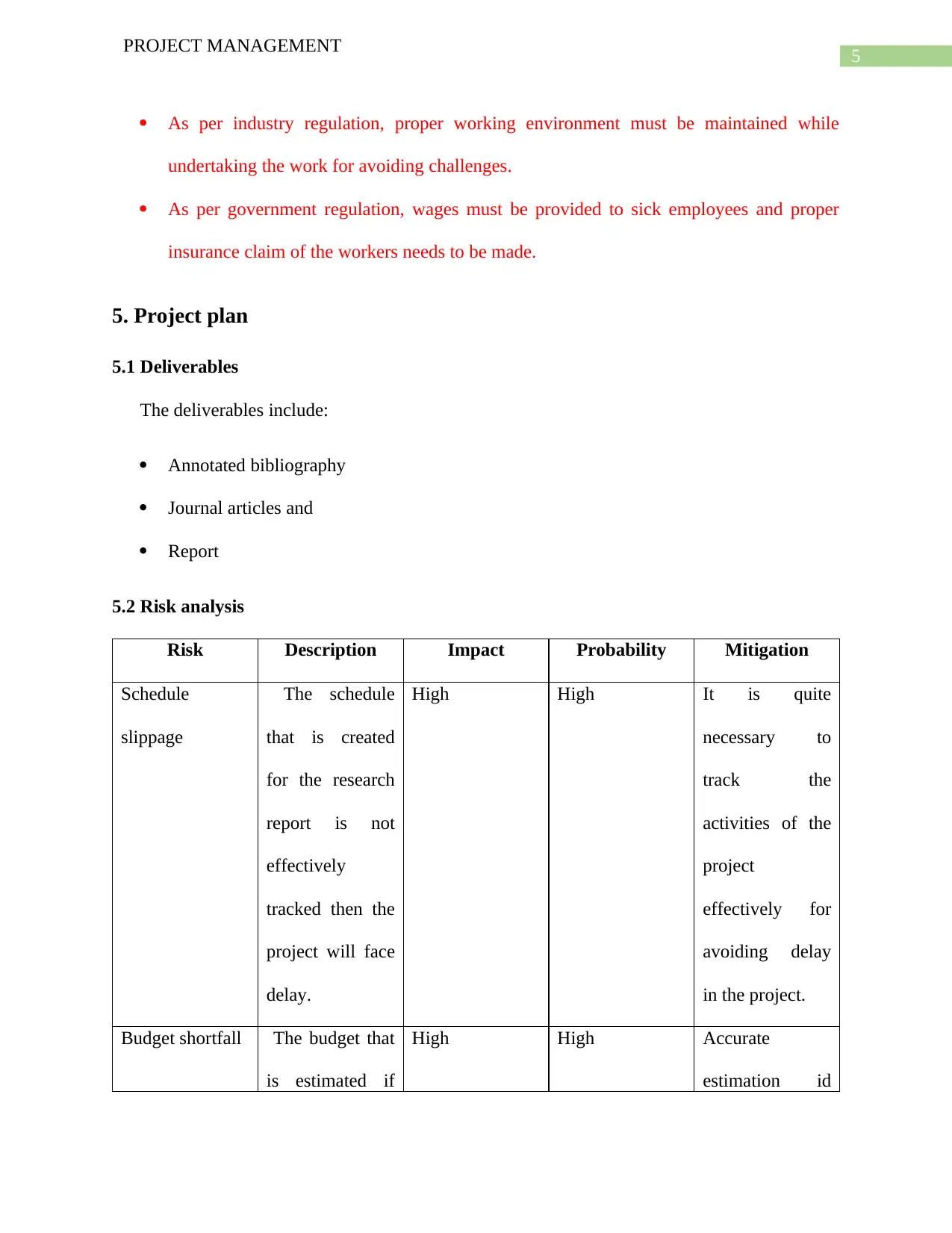
5
PROJECT MANAGEMENT
As per industry regulation, proper working environment must be maintained while
undertaking the work for avoiding challenges.
As per government regulation, wages must be provided to sick employees and proper
insurance claim of the workers needs to be made.
5. Project plan
5.1 Deliverables
The deliverables include:
Annotated bibliography
Journal articles and
Report
5.2 Risk analysis
Risk Description Impact Probability Mitigation
Schedule
slippage
The schedule
that is created
for the research
report is not
effectively
tracked then the
project will face
delay.
High High It is quite
necessary to
track the
activities of the
project
effectively for
avoiding delay
in the project.
Budget shortfall The budget that
is estimated if
High High Accurate
estimation id
PROJECT MANAGEMENT
As per industry regulation, proper working environment must be maintained while
undertaking the work for avoiding challenges.
As per government regulation, wages must be provided to sick employees and proper
insurance claim of the workers needs to be made.
5. Project plan
5.1 Deliverables
The deliverables include:
Annotated bibliography
Journal articles and
Report
5.2 Risk analysis
Risk Description Impact Probability Mitigation
Schedule
slippage
The schedule
that is created
for the research
report is not
effectively
tracked then the
project will face
delay.
High High It is quite
necessary to
track the
activities of the
project
effectively for
avoiding delay
in the project.
Budget shortfall The budget that
is estimated if
High High Accurate
estimation id
⊘ This is a preview!⊘
Do you want full access?
Subscribe today to unlock all pages.

Trusted by 1+ million students worldwide
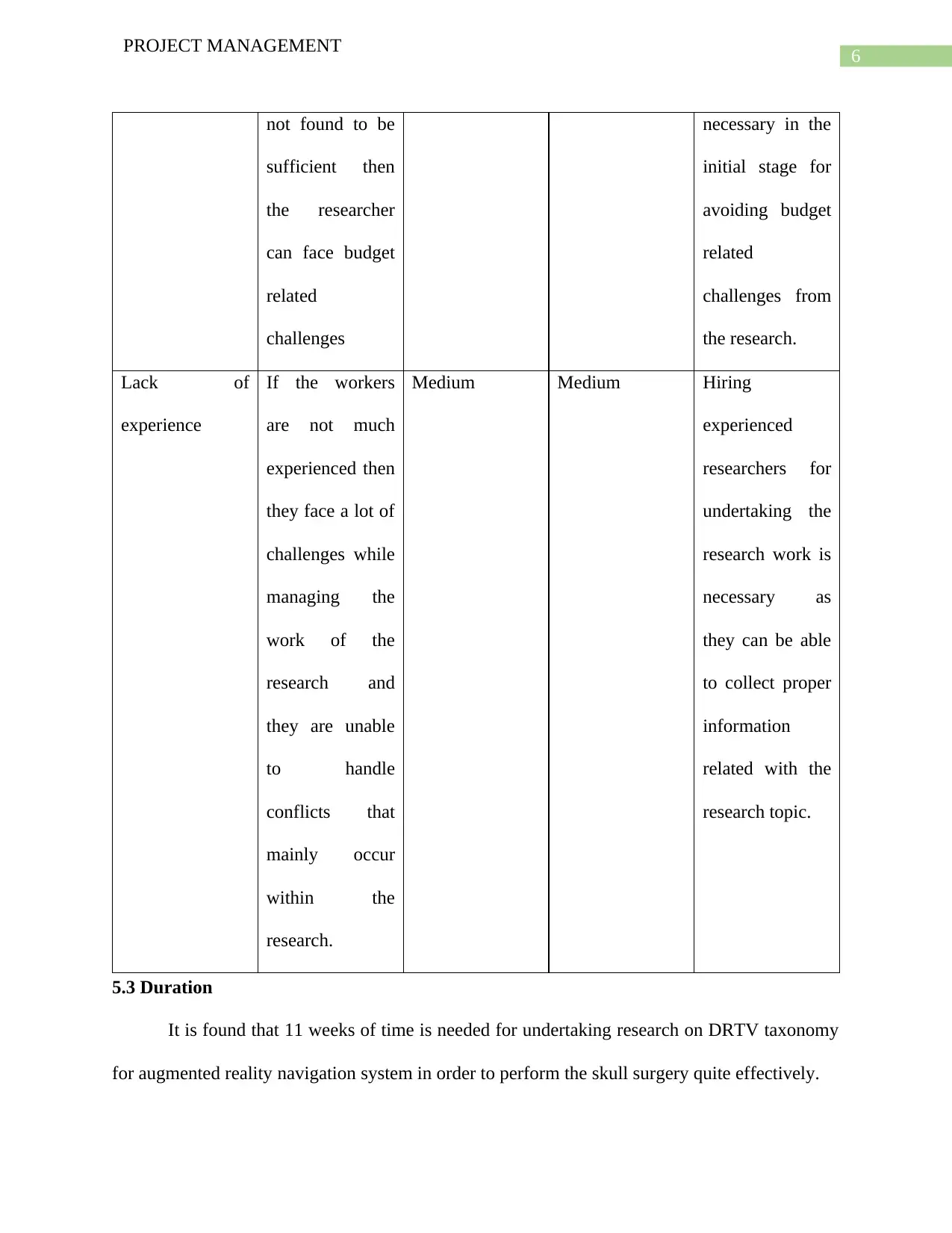
6
PROJECT MANAGEMENT
not found to be
sufficient then
the researcher
can face budget
related
challenges
necessary in the
initial stage for
avoiding budget
related
challenges from
the research.
Lack of
experience
If the workers
are not much
experienced then
they face a lot of
challenges while
managing the
work of the
research and
they are unable
to handle
conflicts that
mainly occur
within the
research.
Medium Medium Hiring
experienced
researchers for
undertaking the
research work is
necessary as
they can be able
to collect proper
information
related with the
research topic.
5.3 Duration
It is found that 11 weeks of time is needed for undertaking research on DRTV taxonomy
for augmented reality navigation system in order to perform the skull surgery quite effectively.
PROJECT MANAGEMENT
not found to be
sufficient then
the researcher
can face budget
related
challenges
necessary in the
initial stage for
avoiding budget
related
challenges from
the research.
Lack of
experience
If the workers
are not much
experienced then
they face a lot of
challenges while
managing the
work of the
research and
they are unable
to handle
conflicts that
mainly occur
within the
research.
Medium Medium Hiring
experienced
researchers for
undertaking the
research work is
necessary as
they can be able
to collect proper
information
related with the
research topic.
5.3 Duration
It is found that 11 weeks of time is needed for undertaking research on DRTV taxonomy
for augmented reality navigation system in order to perform the skull surgery quite effectively.
Paraphrase This Document
Need a fresh take? Get an instant paraphrase of this document with our AI Paraphraser
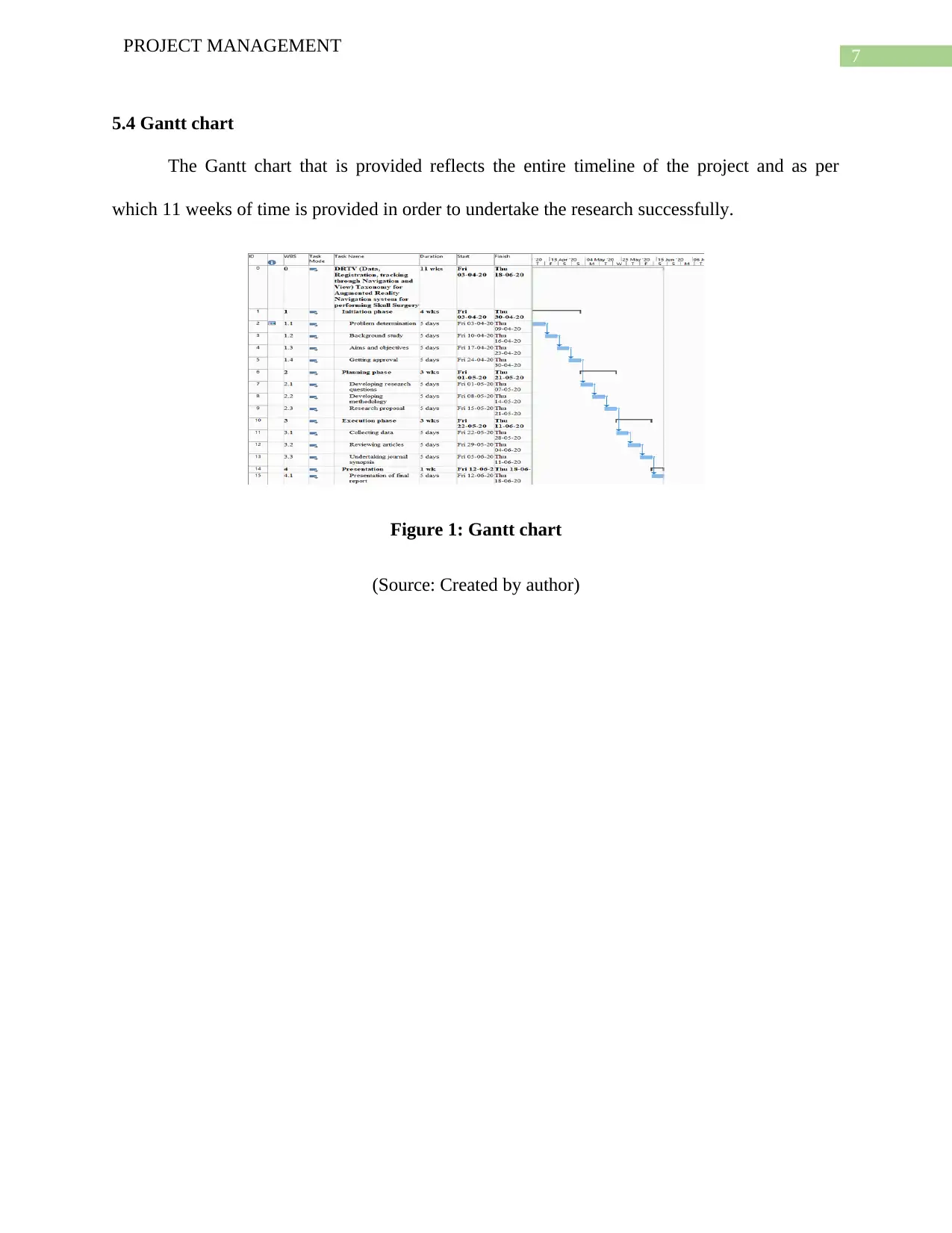
7
PROJECT MANAGEMENT
5.4 Gantt chart
The Gantt chart that is provided reflects the entire timeline of the project and as per
which 11 weeks of time is provided in order to undertake the research successfully.
Figure 1: Gantt chart
(Source: Created by author)
PROJECT MANAGEMENT
5.4 Gantt chart
The Gantt chart that is provided reflects the entire timeline of the project and as per
which 11 weeks of time is provided in order to undertake the research successfully.
Figure 1: Gantt chart
(Source: Created by author)
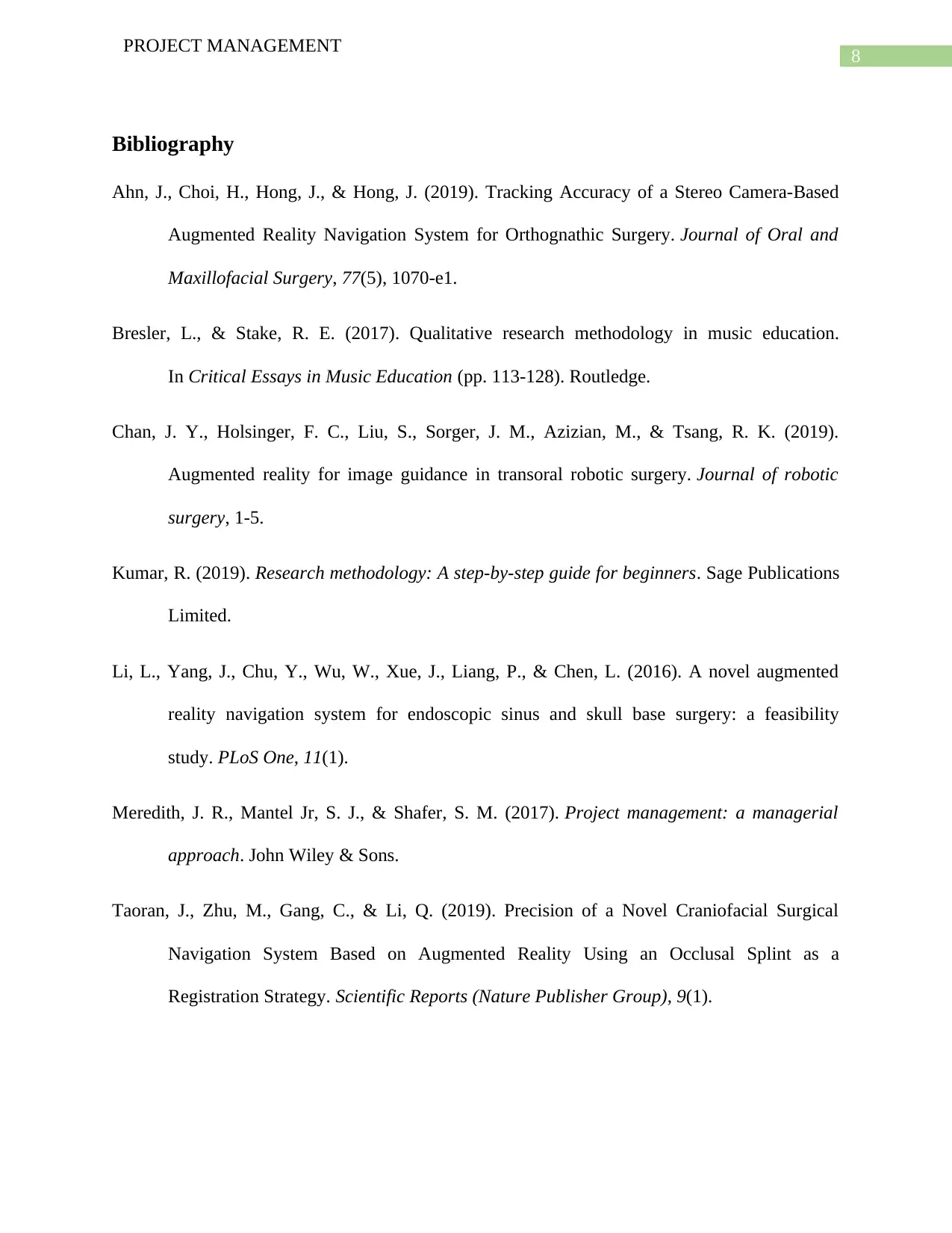
8
PROJECT MANAGEMENT
Bibliography
Ahn, J., Choi, H., Hong, J., & Hong, J. (2019). Tracking Accuracy of a Stereo Camera-Based
Augmented Reality Navigation System for Orthognathic Surgery. Journal of Oral and
Maxillofacial Surgery, 77(5), 1070-e1.
Bresler, L., & Stake, R. E. (2017). Qualitative research methodology in music education.
In Critical Essays in Music Education (pp. 113-128). Routledge.
Chan, J. Y., Holsinger, F. C., Liu, S., Sorger, J. M., Azizian, M., & Tsang, R. K. (2019).
Augmented reality for image guidance in transoral robotic surgery. Journal of robotic
surgery, 1-5.
Kumar, R. (2019). Research methodology: A step-by-step guide for beginners. Sage Publications
Limited.
Li, L., Yang, J., Chu, Y., Wu, W., Xue, J., Liang, P., & Chen, L. (2016). A novel augmented
reality navigation system for endoscopic sinus and skull base surgery: a feasibility
study. PLoS One, 11(1).
Meredith, J. R., Mantel Jr, S. J., & Shafer, S. M. (2017). Project management: a managerial
approach. John Wiley & Sons.
Taoran, J., Zhu, M., Gang, C., & Li, Q. (2019). Precision of a Novel Craniofacial Surgical
Navigation System Based on Augmented Reality Using an Occlusal Splint as a
Registration Strategy. Scientific Reports (Nature Publisher Group), 9(1).
PROJECT MANAGEMENT
Bibliography
Ahn, J., Choi, H., Hong, J., & Hong, J. (2019). Tracking Accuracy of a Stereo Camera-Based
Augmented Reality Navigation System for Orthognathic Surgery. Journal of Oral and
Maxillofacial Surgery, 77(5), 1070-e1.
Bresler, L., & Stake, R. E. (2017). Qualitative research methodology in music education.
In Critical Essays in Music Education (pp. 113-128). Routledge.
Chan, J. Y., Holsinger, F. C., Liu, S., Sorger, J. M., Azizian, M., & Tsang, R. K. (2019).
Augmented reality for image guidance in transoral robotic surgery. Journal of robotic
surgery, 1-5.
Kumar, R. (2019). Research methodology: A step-by-step guide for beginners. Sage Publications
Limited.
Li, L., Yang, J., Chu, Y., Wu, W., Xue, J., Liang, P., & Chen, L. (2016). A novel augmented
reality navigation system for endoscopic sinus and skull base surgery: a feasibility
study. PLoS One, 11(1).
Meredith, J. R., Mantel Jr, S. J., & Shafer, S. M. (2017). Project management: a managerial
approach. John Wiley & Sons.
Taoran, J., Zhu, M., Gang, C., & Li, Q. (2019). Precision of a Novel Craniofacial Surgical
Navigation System Based on Augmented Reality Using an Occlusal Splint as a
Registration Strategy. Scientific Reports (Nature Publisher Group), 9(1).
⊘ This is a preview!⊘
Do you want full access?
Subscribe today to unlock all pages.

Trusted by 1+ million students worldwide
1 out of 9
Related Documents
Your All-in-One AI-Powered Toolkit for Academic Success.
+13062052269
info@desklib.com
Available 24*7 on WhatsApp / Email
![[object Object]](/_next/static/media/star-bottom.7253800d.svg)
Unlock your academic potential
Copyright © 2020–2025 A2Z Services. All Rights Reserved. Developed and managed by ZUCOL.





